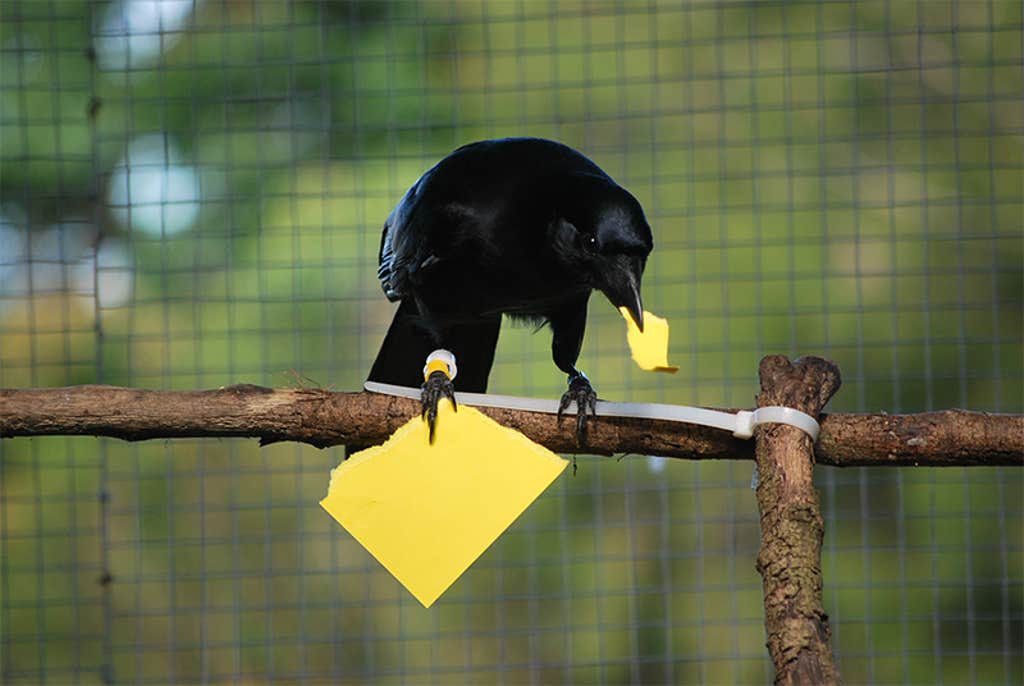Crows and ravens, which belong to the corvid family, are known for their high intelligence, playful natures, and strong personalities. They hold grudges against each other, do basic statistics, perform acrobatics, and even host funerals for deceased family members. But we keep learning new things about the savvy of these birds, and how widespread that savvy is among the corvid family.
Earlier this year, a team of researchers from Lomonosov Moscow State University in Russia and the University of Bristol found that a species of crow called the hooded crow—which has a gray bust and black tail and head feathers, making it look like it is wearing a “hood”—is able to manage a mental feat we once thought was unique to humans: to memorize the shape and size of an object after it is taken away—in this case a small piece of colored paper—and to reproduce one like it.
This kind of feat, according to animal behavior researchers, requires the ability to form “mental templates.” Essentially, a mental template is an image in the mind of what a particular object looks like, even when that object is not present. Mental templates allow animals to create tools, which can be used to get food or make a stronger nest, both ultimately leading to a better chance of survival. They might also make it possible for individuals to learn about tool making from other members of their species—and to pass along improvements in tool making over time, often called “cumulative culture,” which so far seems rare among non-human animals.
Young crows learn how to make different types of tools by stealing their parent’s tools.
We have been looking for evidence that different corvid and other bird species can create mental templates since at least 2002. That year, researchers published findings showing that Betty, a captive New Caledonian crow, was able to spontaneously bend a piece of wire to create a hook that she could use to grab a hard-to-reach treat. Betty had successfully used a pre-made hook to obtain the treat in earlier trials but in follow-up tasks didn’t seem to fully understand how hooks work. The researchers decided she must have formed a mental template of the hook, which she then reproduced. So far, researchers have found that Goffin cockatoos, a kind of parrot, can also create tools spontaneously, which could indicate similar mental agility.
But the new hooded crow findings suggest that the ability to learn this way could be more widespread than we thought, says Sarah Jelbert, a comparative psychologist who studies animal behavior at the University of Bristol and is one of the authors of the study. Creating and using mental templates might be a skill that evolved in the ancestor of all corvids, the “Corvida” branch of songbirds, or perhaps it is even shared more broadly across the animal kingdom, she says.
For their study, Jelbert and her colleagues first trained three hooded crows—Glaz (15 years old), Rodya (4 years old), and Joe (3 years old)—to recognize pieces of paper of different sizes and colors. To do this, they exposed the birds to “template” pieces of paper in different colors and sizes for several minutes before removing them—and then rewarded the birds for dropping scraps that matched these templates into a small slit.

The crows were next given the opportunity to manufacture versions of these objects in exchange for a reward. The researchers found that all three crows manufactured objects that matched the original template object they had been rewarded for in both color and size—even though the treats in this second stage of the experiment were awarded at random. The researchers also observed that Glaz, the oldest of the three hooded crows, seemed to be the most proficient at making scraps that looked like the ones the bird was trained on. This finding suggested to them that mental templates may be linked to experience garnered with age.
“Unlike humans, who regularly copy each other’s behavior … we don’t have much evidence that crows will watch each other and deliberately copy what another crow is doing,” Jelbert says. However, they will steal each other’s tools—in particular, juvenile crows often steal their parents’ tools when they are young. So it’s possible that young crows learn how to make different types of tools from experience stealing their parent’s tools, using them, remembering what these tools look like, and then trying to create something similar, Jelbert says.
What qualifies as a mental template, and how flexible these templates are, seems to be up for some debate. Research suggests birdsong and mating practices may rely on certain kinds of mental templates, which can backfire if a bird memorizes behavior from the wrong species. “For example, if a song sparrow gets imprinted on the song of a swamp sparrow and sings a song from a different species rather than its own, it will have difficulty finding mating partners,” explains Andreas Nieder, a professor of animal psychology at the University of Tübingen and a lead researcher on corvid neuroscience, who was not involved in this study. “Similarly, if one finch species gets sexually imprinted on another, it may show courtship displays to the wrong species in adulthood.”
Nieder says this kind of imprinting can become fixed in the bird’s brain, and is not changeable even in new environments. “In this case, templates may no longer represent intelligence but rather the opposite,” he adds. Researchers have not yet determined whether mental templates related to tool making remain flexible, though there is some evidence in New Caledonian crows that they may evolve.
For biologists and comparative psychologists, understanding the ways corvids use mental templates can help to illuminate not just the nature of bird intelligence, but of intelligence across the animal kingdom and evolutionary time. ![]()
Lead image: RuqayaMai / Shutterstock